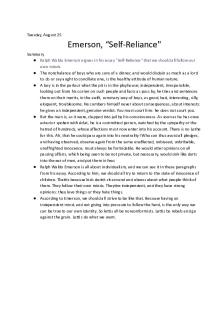Schaffer & Emerson study PDF

| Title | Schaffer & Emerson study |
|---|---|
| Course | Clinical Psychology |
| Institution | Anglia Ruskin University |
| Pages | 2 |
| File Size | 107.7 KB |
| File Type | |
| Total Downloads | 28 |
| Total Views | 123 |
Summary
practise...
Description
Lesson 2: Development of Attachment Schaffer and Emerson (1964) The researchers designed a large-scale longitudinal study to find out more information about the development of attachment. Over a period of two years they followed 60 infants from a mainly working class area of Glasgow, keeping a detailed record of their observations. The infants were observed every four weeks until they were 1 year old and then again at 18 months. At the start of the investigation the youngest participant was 5 weeks and the oldest was 23 weeks. Attachment was measured in two ways: Using separation protest in 7 everyday situations. The infant was left alone in a room, left with other people, left in his/her pram outside the house, left in his/her pram outside the shops, left in his/her cot at night, put down after being held by an adult, or passed by while sitting in his/her cot or chair. Using stranger anxiety. Every visit started with the researcher approaching the infant and noting at what point the infant started to whimper, thus displaying anxiety. Separation protest and stranger anxiety are signs that an attachment has formed. Before this stage of specific attachments infants show neither of these behaviours.
Schaffer and Emerson found that: Half of the children showed their first specific attachment between 25 and 32 weeks (6-8 months). Fear of strangers occurred about a month later in all the children. The intensity of attachment peaked in the first month after attachment behaviour first appeared, as measured by the strength of separation protest. However there were large individual differences. Intensely attached infants had mothers who responded quickly to their demands (high responsiveness) and who offered the child the most interaction. Infants who were weakly attached had mothers who failed to interact.
Multiple attachments: soon after one main attachment was formed, the infants also became attached to other people. By 18 months very few (13%) were attached to only one person, 31% had five or more attachments, such as father, grandparent, or older sibling. In 65% of the children the first specific attachment was to the mother, and in a further 30% the mother was the first joint object of attachment. Time spent with infant: in 39% of the cases the person who usually fed, bathed, and changed the child was not the child’s primary attachment object. In other words, many of the mothers were not the person who performed these tasks yet they were the main attachment object.
Questions 1) Explain what is meant by separation anxiety and stranger anxiety 2) Evaluate Schaffer & Emerson's study...
Similar Free PDFs

Schaffer & Emerson study
- 2 Pages

Emerson, “Self-Reliance\"
- 1 Pages

Ralph Waldo Emerson - Apuntes 11
- 6 Pages

Article 1 - Emerson and Lewis 1943
- 15 Pages

Amor Y Respeto - Dr Emerson Eggerichs
- 237 Pages

Case study must study
- 32 Pages

Cal Cheat Sheet - study study study
- 11 Pages

Sappho+Study+Guide - Study Guide
- 5 Pages

Tesco-Case-Study - Case Study
- 3 Pages

170 Study Notes - Exam Study
- 1 Pages

Study Guide - HR - Study Guide
- 17 Pages
Popular Institutions
- Tinajero National High School - Annex
- Politeknik Caltex Riau
- Yokohama City University
- SGT University
- University of Al-Qadisiyah
- Divine Word College of Vigan
- Techniek College Rotterdam
- Universidade de Santiago
- Universiti Teknologi MARA Cawangan Johor Kampus Pasir Gudang
- Poltekkes Kemenkes Yogyakarta
- Baguio City National High School
- Colegio san marcos
- preparatoria uno
- Centro de Bachillerato Tecnológico Industrial y de Servicios No. 107
- Dalian Maritime University
- Quang Trung Secondary School
- Colegio Tecnológico en Informática
- Corporación Regional de Educación Superior
- Grupo CEDVA
- Dar Al Uloom University
- Centro de Estudios Preuniversitarios de la Universidad Nacional de Ingeniería
- 上智大学
- Aakash International School, Nuna Majara
- San Felipe Neri Catholic School
- Kang Chiao International School - New Taipei City
- Misamis Occidental National High School
- Institución Educativa Escuela Normal Juan Ladrilleros
- Kolehiyo ng Pantukan
- Batanes State College
- Instituto Continental
- Sekolah Menengah Kejuruan Kesehatan Kaltara (Tarakan)
- Colegio de La Inmaculada Concepcion - Cebu




